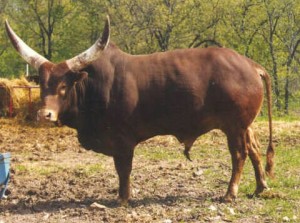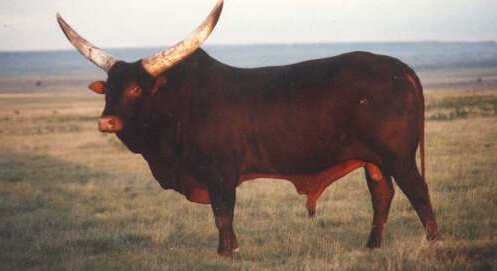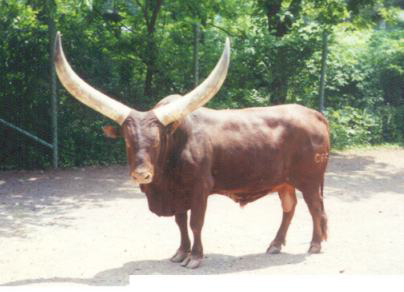Bigelow Exotic Cattle is the home of Ron Potts in Arkansas.
Visit them on the web at http://bigelowexoticcattle.com/home.
Bigelow Exotic Cattle is the home of Ron Potts in Arkansas.
Visit them on the web at http://bigelowexoticcattle.com/home.
King Louis was a large red bull sired by the famous Valentino of the Busch Gardens, Tampa Florida breeding program and out of the cow Fraulien who was an imported cow from the Frankfurt Zoo in Germany. Louis shows up many times in bloodlines of the World Watusi Association records. Although he was used on a few foundation pure cows he was ultimately used extensively on percentage animals by Liar’s Lake of Sparta, Missouri producing over 200 offspring.

Liar’s Lake Kenya Jim was born at Texas Safari in 1988. He has been used extensively as a sire by Liar’s Lake having produced over one hundred calves. Jimmy was sired by Heinz, of the Catskill Game Farm breeding lines, and out of Kathy, one of the highest selling Watusi cows of the last decade. Kathy was from the Rare Animal Survival Center, Ocala, Florida.
Lolli’s Spit Fire is a wonderful example of close line breeding producing an outstanding individual and a beautiful calf of Foxfire. His horns measure 26 inches in circumference at the base, making him one of the largest horned individuals in the breed. He was used for a few years by the Lolli Brothers of Macon, Missouri prior to finding a home with Heiken’s Ark in Des Moines, Iowa.
Masterpiece was Grand Champion Foundation Pure bull at the Colorado State Fair multiple times, a well deserved honor. Masterpiece was one of the largest bulls in the breed weighing in at 2305 pounds at the age of 5 years. He was the product of the Great Adventure Park in Jackson, New Jersey in 1980. He was used extensively by the Zavislan Ranches in Pueblo West, Colorado mostly on percentage animals.

Rambo was born at the Rare Animal Survival Center in Ocala, Florida and proved the successful result of one of the original breeding programs in the United States. Rambo had it all, a body weight of 1600 pounds; horn circumference of 23 inches; 41 inch length to each individual horn and 54 inches from tip to tip (not measured along the curves). There is no question that this bull was one of the best representatives of this special breed. He was used by the famous Catskill Game Farm in their purbred program for most of his life and can be found in the background of many of the top animals of the Watusi breed. 
|
|||||||||||||||
| Pedigree generated by PedigreeQuery.com |
100% Pure Watusi Ankole cattle are extremely rare worldwide. When the World Watusi Association was formed the decision was made to crossbreed the cattle to increase the gene pool and to more widely expose the breed to the public. To this end an upbreeding program was created as follows:
| FP Bull | NP Bull | |||
| FP cow | ♀♂ = FP | ♀♂ = NP | ||
| NP cow | ♀♂ = NP | ♀♂ = NP | ||
| ¾ blood cow | ♀ = NP | ♂ = ⅞ | ♀ = NP | ♂ = ⅞ |
| ½ blood cow | ♀♂ = ¾ | ♀♂ = ¾ | ||
| Grade cow/other | ♀♂ = ½ | N/A | ||
The most difficult part of raising animals is facing the fact that no matter how much attention and care that you give them, no matter how healthy they are, they will eventually die. It is hard when any living being passes away, but sometimes the loss hits on multiple levels. On November 30, 1999 we were faced with the loss of Liar’s Lake Kenya Jim our longtime chief herdsire. Jimmy, as we knew him, is an icon in the Watusi industry having produced a great number of calves. To those of us at Liar’s Lake he was the personal favorite.
In 1989 we went to the WWA sanctioned sale at Macon, Missouri in search of an outcross yearling bull that we could put with yearling heifers. We were impressed when we saw this red bull calf in the Texas Safari consignment. He had great horn and body for his age, but what impressed us the most was the temperament that he displayed. He was a gentleman even at that young age. Jimmy was the 1988 son of the Catskill Game Farm Bull, Heinz and Kathy a great foundation pure cow of the Rare Animal Survival Center in Ocala, Florida. We gave him 12 heifers for his first time out and he presented us with 10 beautiful calves. This was the start of a great breeding history and career.
Jimmy was more than just a bull to us, he taught many lessons to us about breeding and handling Watusi that have proved invaluable. I have often lectured people new to the industry about the dangers of handling animals that are so much larger that you are. Jimmy himself brought home to me the dangers of having a large animal that is too friendly. This was not really for the normal reason of becoming too aggressive when he matured, but rather because I discovered how small I was compared to him.
Years ago I was out checking a fence line where we had set a trap for some deer that had liberated themselves into the wrong pen. The ‘wrong pen’ being the one that Jimmy and his girls were in. At the time he was about 18 months old, so probably only around 800 pounds. He came up to me as I got out of the truck so I accommodated him by scratching his back and behind his horns. When I was done I turned my back to him and headed for the deer trap.
Now this trap was a simple arrangement by which a perpendicular fence was installed to an existing structure so that the deer could return to their original pen without allowing access to the other animals (such as the Watusi). My husband had previously walked through the trap so I headed there as well. I forgot that my body needed a larger gap than his to pass through, I couldn’t squeeze through the hole. I turned around, my back to the fence and there was Jimmy. He had followed me after I scratched him wanting more attention, but I had not noticed him. He lowered his head and pressed it against my stomach so that I could scratch behind his horns. With this motion he pressed my back up against the fence and pinned me to it. He then started to rub up and down on me. Here I was, trapped and facing either being squashed through the squares of the fence like through a colander or having him scrape my chest flat with his horns. The horns, although proportionately small because he was young, were still very effective in trapping me and making me quite nervous. The only solution that I could see was to keep myself positioned between them and holding on with my hands. This produced the effect that as he raised and lowered his head he simply lifted me up and down, again and again. This action, which would have been impossible for a human, was as effortless for this young bull as turning a page of a book is for us. Fortunately his attention span was limited and when I was not rubbing him the way he wanted he repositioned himself and I was able to move away from the fence. I was frightened, but not injured and as the saying goes, “what doesn’t kill you makes you stronger” so the lesson that I learned was well worth the experience.
As Jimmy matured he developed into a large, very well built animal whose temperament remained as easy going and sweet as an adult as it was as a youngster. Throughout his life he remained consistently easy to handle and feed. He still enjoyed a backscratch up to the end.
He was a great producer siring quality calves with good horn and body. Many of his calves have outdone him in horn and are still growing into the body. His progeny have made him proud by winning in the show ring. His offspring have included Colorado State Fair winners as Grand Champion Foundation Pure Bull and Reserve Champion Native Pure Cow with the same results at the All American Watusi Show. His legacy will continue long after his passing. To those of us that knew him personally the loss will be felt for just as long.
EDITOR’S NOTE: In doing research on the Watusi breed, Marleen Felius of the Netherlands made an interesting discovery. We [WWA] had previously reported that the only Watusi cattle ever brought out of Africa were brought out in 1929 and 1930 by Walter Schulz and his father Christoph. Now it appears that there was one more small shipment of 6 head also brought to Germany from Africa in about 1939. The following is a copy of part of the article which appeared in the monthly journal of the Hellabrunn Zoo at Munchen, Germany dated April 1939. Reprinted with permission from Watusi World, Vol 4, Issue II.
By: Marleen Felius
Before the World War [I], the German explorer Professor D. Berger visited East Africa and the behind lying country of the Sultan of Uganda, in the source area of the Nile, between Lake Victoria and Lake Rudolf. Berger found a negro state with crowded cities from a hight standing negro architecture and a densly populated agricultural and cattle keeping country.